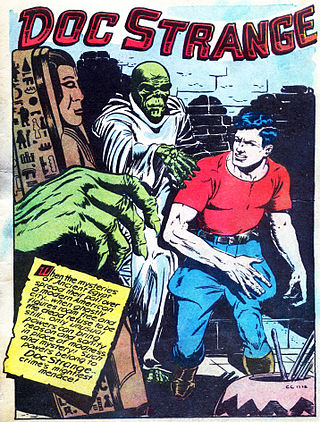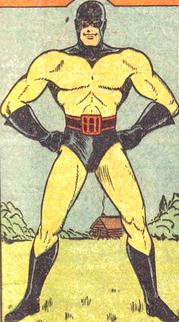
Archie Comic Publications, Inc. is an American comic book publisher headquartered in the village of Pelham, New York. The company's many titles feature the fictional teenagers Archie Andrews, Jughead Jones, Betty Cooper, Veronica Lodge, Reggie Mantle, Sabrina Spellman, Josie and the Pussycats and Katy Keene. The company is also known for its long-running Sonic the Hedgehog comic series, which it published from 1992 until 2016.

The Fly is a superhero appearing in American comic books published by Red Circle Comics, an imprint of Archie Comics. He was created by Joe Simon as part of Archie's "Archie Adventure Series" and later camped up as part of the company's Mighty Comics line. He first appeared in The Double Life of Private Strong #1 ; however, his origin story and first "full-length" appearance were in Adventures of the Fly #1.

The Mighty Crusaders is a fictional superhero team published by Archie Comics. The team originally appeared in Fly-Man No. 31, #32 and No. 33 before being launched in its own title, The Mighty Crusaders. Written by Superman co-creator Jerry Siegel, the series lasted seven issues before being cancelled. The team was revived under Archie's Red Circle Comics line in 1983. In 1992 DC Comics licensed the characters and relaunched the team as The Crusaders, aiming the comic at younger readers as part of its !mpact line. This series lasted eight issues, cover-dated May to December 1992.

Doc Strange is a Golden Age comic book superhero who originally appeared in Thrilling Comics #1 in February 1940. The character continued in Thrilling Comics until issue #64. He also appeared in America's Best Comics #1-23 and 27.

Dark Circle Comics is an imprint of Archie Comic Publications, Inc. Under its previous name, Red Circle Comics, it published non-humor characters, particularly superheroes in the 1970s and 1980s.

The Shield is the name of several superheroes created by MLJ. Appearing months before Captain America, the Shield has the distinction of being the first superhero with a costume based upon United States patriotic iconography. The character appeared in Pep Comics from issue #1 to #65.
Thunderbunny is a comic book about a boy who transforms into a superhero resembling a large pink humanoid rabbit. It was created by Martin L. Greim.

Wonder Man is a fictional superhero created by American cartoonist Will Eisner, whose only appearance was in the comic book Wonder Comics #1. The character is of some historical significance due to a lawsuit that resulted from his only appearance.

The Black Hood is the name of several fictional characters created by MLJ Comics during the period known as the "Golden Age of Comic Books". The Black Hood first appeared in Top-Notch Comics #9, October 1940 and became one of MLJ's most popular characters. He has been in four self-titled series as well as in his own radio show, Black Hood (1943–1944). In recent decades, the Black Hood has been sporadically licensed and published by DC Comics. However, the character reappeared under Archie Comics' Dark Circle Comics line in 2015.

The Fox is the name of two superheroes that appear in periodicals published by MLJ Comics and later Dark Circle Comics.
The Web is a superhero created by MLJ Comics in 1942 by artist John Cassone and an unknown writer. The character was published in Zip Comics until 1943, and was later brought back in 1966 to appear in Archie's revived superhero line. DC Comics licensed Archie's superhero characters in 1991, and brought a new revival of the character to life in 2009.

Captain Flag is a superhero created by MLJ Comics' writer Joe Blair and artist Lin Streeter. He first appeared in September 1941, in issue #16 of Blue Ribbon Comics. He continued until the last issue, Blue Ribbon Comics #22.

Wildfire is a fictional superhero in the DC Comics universe. One of the first female superheroes, she was originally published by Quality Comics during what comics historians and fans called the Golden Age of comic books. With her luxurious mane of red hair and revealing costume, she has been called "the sexiest super-hero of 1941".
The Fantom of the Fair is one of the earliest published Golden Age superheroes. He debuted in Centaur Publications' Amazing Mystery Funnies vol. 2, #7, the overall 11th issue of that title. He premiered, according to cover dates, the same month as DC Comics' Sandman, Fox Publications' The Flame, and Centaur's Masked Marvel. He was created by Paul Gustavson, who had previously created the Arrow for Centaur.
The Green Mask is the name of two comic book superheroes, both published by Fox Feature Syndicate. Both are in the public domain with some of the original stories having been reprinted by AC Comics.

Amazing-Man is a comic book superhero whose adventures were published by Centaur Publications during the 1930s to 1940s in the Golden Age of Comic Books. Historians credit his creation variously to writer-artist Bill Everett or to Everett together with Centaur art director Lloyd Jacquet. Amazing-Man first appeared in Amazing-Man Comics #5 —there were no issues numbered #1–4).

Pyroman is a fictional superhero that appeared in comic books published by Nedor Comics. His first appearance was in Startling Comics #18, with art by Jack Binder. This character was later revived by both AC Comics and America's Best Comics.

Firefly is a superhero created by Harry Shorten and Bob Wood for MLJ Comics in 1940. He first appeared in Top-Notch Comics #8. Artist Warren King and writer Joe Blair loaned their talents to many of the Firefly's installments.

The Hangman is the name of several fictional superheroes that appear in periodicals published by MLJ Comics and later Dark Circle Comics.

Crimebuster is a fictional boy hero, appearing as the lead feature in Boy Comics in the 1940s and 1950s. Dressed in a hockey uniform and cape, and accompanied by a performing monkey named Squeeks, he fights crime to avenge his parents' deaths. He is described by Joe Brancetelli in The World Encyclopedia of Comics as "a hero, yes, but first a boy... arguably the best-handled boy's adventure feature ever to appear in comics." Some sources credit the character solely to Charles Biro; others co-credit Bob Wood, co-credited on the first cover of the new Boy Comics title.
















